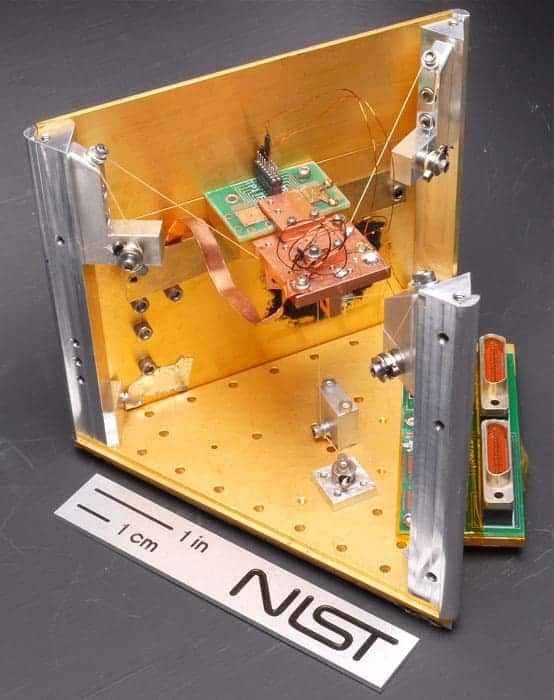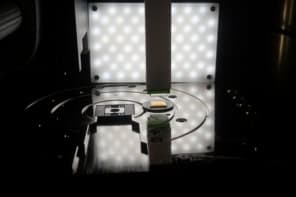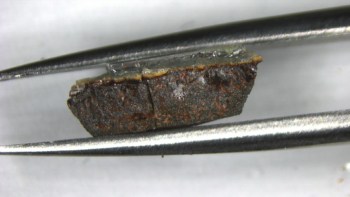
Physicists in the US have built a new solid-state refrigerator that provides continuous cooling of objects to temperatures below 300 mK. The device has no moving parts and uses 48 tiny quantum-tunnelling junctions to cool a copper plate a million times heavier than the refrigerating elements themselves. The team believes that the device could be further optimized and could find use in refrigeration applications where conventional cryogenics are difficult to implement – such as cooling detectors on space missions.
Temperatures below about 300 mK are integral to many areas of modern physics research from quantum computers to dark-matter detection. However, temperatures below about 300 mK cannot be reached by simply cooling with liquid helium. Conventional cooling to millikelvin temperatures is done using a dilution refrigerator, which involves pumping helium isotopes. While extremely effective, dilution refrigerators can be difficult to implement in specialized applications such as cooling detectors in space. An alternative technique is adiabatic demagnetization, which is also unwieldy because it involves placing the sample in a powerful magnetic field that is repeatedly turned on and off.
Researchers have for years been seeking a viable solid-state cryogenic refrigerator – ideally a system that can cool objects the size of a computer chip to below 300 mK simply by running electric current through it. Various proposals have been advanced and success has been achieved in cooling small objects less than 1 mm in size. In 2005 Joel Ullom’s team at the National Institute for Standards and Technology (NIST) in Boulder, Colorado, unveiled a cooler based on quantum tunnelling that can chill objects much larger than the refrigerating elements – which were extremely small. However, the object to be cooled had to be integrated onto a cold membrane at the time of manufacture, so the refrigerator was not reusable.
A ‘true’ refrigerator
Now Ullom and colleagues have created a new solid-state refrigerator and used it to cool a removable copper stage sized 2.5 cm from 290 mK to 256 mK over the course of 18 hours. The stage was thermally connected to a membrane, while remaining electrically isolated.
Ullom explains that the electrical isolation is important: “This is why we consider the device to be a true refrigerator,” he says. “Just as it would be very awkward if your household refrigerator had current running through whatever you put in it, so too it would be awkward if there was current running through your payload from the refrigeration process.”
Thermal isolation
The membrane, conversely, was electrically (but not thermally) connected to the power supply using thin superconducting wires. This isolation means that the device can be connected to a standard power supply or even a 9 V battery.
Attached to the membrane are a series of junctions, each comprising a 30-nm-thick layer of normal conductor and a 300-nm-thick layer of superconductor, separated by a very thin 1 nm layer of insulator. The circulating current creates a potential difference across these junctions. The hotter, more energetic electrons are more likely to tunnel across the insulating gap from the normal conductor to the superconductor on the outside. As a result, these hotter electrons are preferentially removed from the system, cooling the stage.
“It’s almost like the way you cool a cup of coffee by blowing on it,” says NIST researcher Peter Lowell. “You remove some of the hottest particles, which cools down the cup of coffee.”
‘Very impressive’
Hervé Courtois at the Néel Institute in Grenoble, France, describes the device as “very impressive”, although he stresses that “in terms of physics, there is nothing new”. He explains, “The point is that they can couple the electronic cooler and this copper stage, which could be anything. It could be a detector for astronomy or any kind of thermometer.”
Courtois cautions, however, that the device will need to get to colder temperatures before it can replace more complex refrigerators in devices such as the Planck Cosmic Microwave Background detectors. “I think the next step is to start from 300 mK and go down to 100 mk,” he says. “For me this 10% temperature reduction is a very nice demonstration but it’s not really useful. I think they can manage to get down further, but the demonstration is still to be made.”
The researchers’ thoughts lie in the same direction. “We would like to cool from 300 mK down to 100 mK,” says Ullom, “and we are also looking at a refrigerator that could start at 100 mK and maybe reach the low tens of millikelvin. That’s a temperature range that is very difficult to access presently.”
Leonid Kuzmin from Chalmers University, Sweden, is more sceptical that they will be able to get down much further, as he points out that the thermal conductance will decrease as the fourth power as the temperature goes down. As a result, Kuzmin thinks it is unrealistic to expect cooling to near 100 mK after only incremental improvements to the NIST device.



